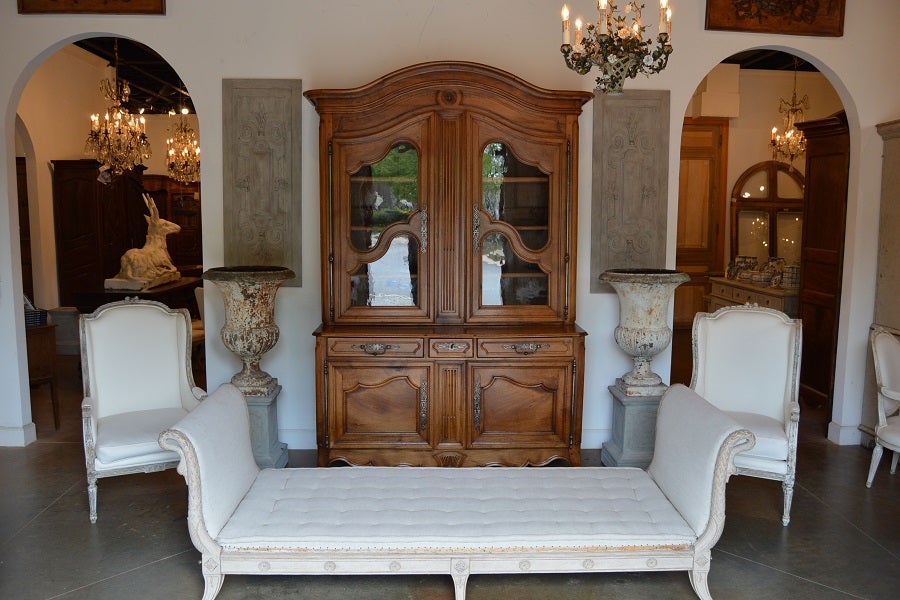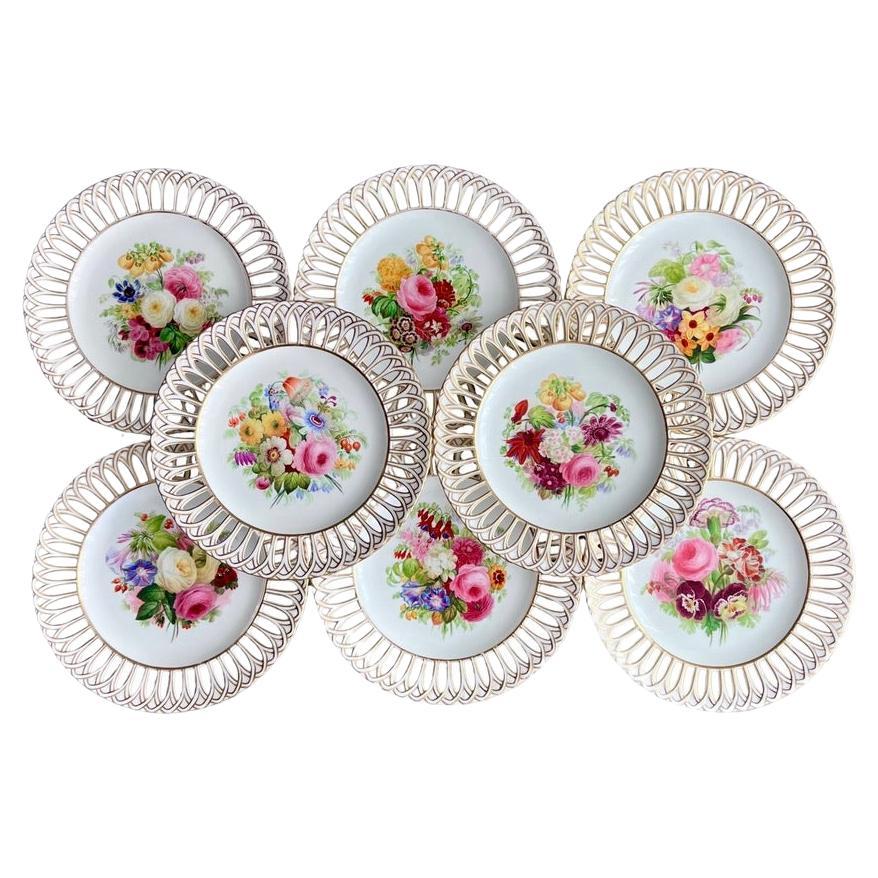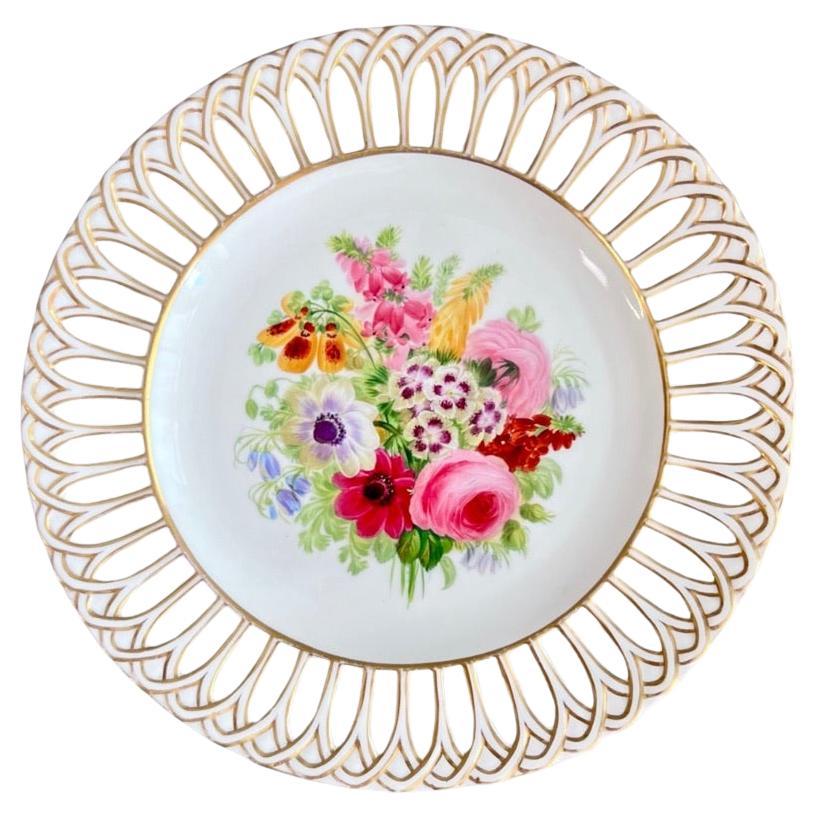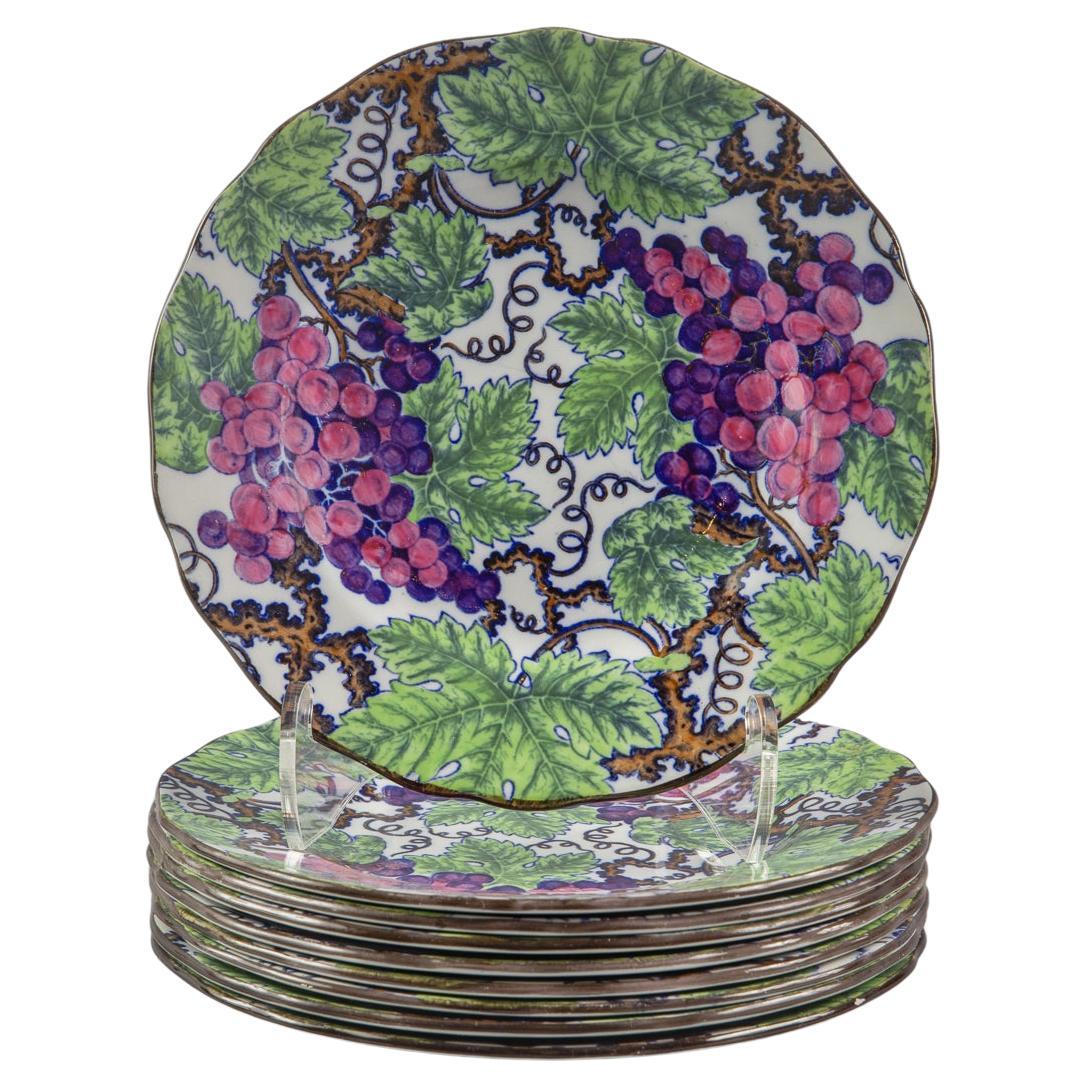Items Similar to English 1850s Copeland Red Border Plates and Compotes with Bouquets of Flowers
Want more images or videos?
Request additional images or videos from the seller
1 of 11
English 1850s Copeland Red Border Plates and Compotes with Bouquets of Flowers
About the Item
A set of four English Copeland red border dessert plates and compotes from the mid 19th century, priced and sold individually. Born in England during the 19th century, each of these four Copeland pieces features a red border, surrounding colorful bouquets of flowers standing out beautifully on a white ground. Pierced with delicate motifs, the borders are scalloped and accented with gilt scrolls, while the compotes are adorned with one or two foliage-themed handles. The dimensions are as followed: the plates are 9"W x 1"H, the compote with single handle is 10"W x 9"D x 2"H while lastly, the compote with two handles is 11.25"W x 8.75"D x 2"H. With their exquisite colors and graceful lines, these English Copeland plates circa 1850 will be lovely decorative accents in any dining room, living room or kitchen.
- Attributed to:Copeland & Garrett Spode (Designer)
- Dimensions:Height: 2 in (5.08 cm)Width: 11.25 in (28.58 cm)Depth: 8.75 in (22.23 cm)
- Materials and Techniques:
- Place of Origin:
- Period:
- Date of Manufacture:circa 1850
- Condition:Wear consistent with age and use. Age appropriate condition. Please look at the various photos available.
- Seller Location:Atlanta, GA
- Reference Number:

About the Seller
5.0
Platinum Seller
These expertly vetted sellers are 1stDibs' most experienced sellers and are rated highest by our customers.
Established in 1982
1stDibs seller since 2007
842 sales on 1stDibs
Typical response time: 1 hour
- ShippingRetrieving quote...Ships From: Atlanta, GA
- Return PolicyA return for this item may be initiated within 1 day of delivery.
More From This SellerView All
- Louis-Philippe Paris Porcelain Fuschia Service Plates and Compotes, Sold EachLocated in Atlanta, GALouis-Philippe period Paris porcelain service plates from the mid-19th century, with fuschia border and floral décor, priced and sold individua...Category
Antique Mid-19th Century French Louis Philippe Porcelain
MaterialsPorcelain
- French 1850s Majolica Asparagus Plate with Scalloped Edge, Three AvailableLocated in Atlanta, GAA French Napoleon III period majolica asparagus plate from the mid-19th century, with scalloped edge, turquoise and chartreuse style tones. We currently have three plates available, ...Category
Antique Mid-19th Century French Napoleon III Dinner Plates
MaterialsMajolica
- Set of 11 French Larchevêque UML Limoges Porcelain Dessert Plates and PlatterBy LimogesLocated in Atlanta, GAA set of 11 French Marc Larchevêque UML Limoges porcelain dessert plates and platter from the 19th century, with floral garlands and gilt trim. Cre...Category
Antique 19th Century French Porcelain
MaterialsPorcelain
- English Porcelain Compotes and Plates with Floral Décor and Gilt TrimLocated in Atlanta, GAEnglish porcelain compotes and plates from the 20th century, with floral décor and gilded trim, priced and sold $275 individually. Attracting our attention with their lovely silhouet...Category
20th Century English Porcelain
MaterialsPorcelain
- French Napoléon III Porcelain de Paris Plates with Floral Décor, Sold SeparatelyBy Porcelaine de ParisLocated in Atlanta, GAFrench Napoléon III period Porcelaine de Paris plates from the late 19th century, with floral décor. The plates are sold individually $145 each, the large platter is priced $225. Cre...Category
Antique Late 19th Century French Napoleon III Dinner Plates
MaterialsPorcelain
- Two English Blue and White Copeland Spode Decorative Plates, Late 19th CenturyBy Copeland SpodeLocated in Atlanta, GATwo English Victorian period blue and white Copeland Spode plates from the late 19th century, with chinoiserie motifs, priced and sold individuall...Category
Antique 19th Century English Late Victorian Dinner Plates
MaterialsEarthenware
You May Also Like
- Copeland Plate, Reticulated with Sublime Flowers by Greatbatch, 1848 (2)By CopelandLocated in London, GBThis is a beautiful plate made by Copeland in 1848. It is decorated with a sublimely painted flower arrangement by the artist Greatbatch. We have two sets of 8 of these plates available, as well as a few more separate ones; please see separate listings. The Copeland factory was the third iteration of the famous Spode factory, after the "Copeland & Garrett" period which transitioned into the "Copeland" period in about 1833. The Spode/Copeland factory was one of the most prominent potteries right from the start of English porcelain production in the late 1700s to the demise of the industry in the 1960s and ultimate closure in the early 21st Century. In fact it was the founder Josiah Spode who was responsible for the recipe for bone china that made English china production so successful in the two centuries to come. Throughout all the changes, their items have always remained of exceptionally high quality and many of the designs have become iconic. This plate was potted in fine white bone china, the rim meticulously reticulated in the "Gothic" shape. Reticulation was very time consuming and difficult, and just this detail would have made this plate expensive. The sublimely painted flower arrangement painted in the centre were done by Greatbatch, one of the well-known floral artists working for Copeland. Greatbatch was active between 1845 and 1860, and worked together with his brother R. Greatbatch, who was a talented gilder. They exhibited at the Great Exhibition of 1851. This plate would have belonged to a sublimely expensive dessert service. It is stamped with the small blue Copeland mark with interlocking C's, and painted in red with the pattern number 7913, dating it at the year 1848. Documentation: A plate of this service is shown on page 80 of Steven Smith's "Spode & Copeland: Over Two Hundred Years of Fine China and...Category
Antique 1840s English Victorian Dinner Plates
MaterialsPorcelain
- Copeland Set of 8 plates, Reticulated, Sublime Flowers by Greatbatch, 1848By CopelandLocated in London, GBThis is a stunning set of 8 reticulated plates made by Copeland in 1848. Each plate is decorated with a unique sublimely painted flower arrangement by the artist Greatbatch. We have a second set of 8 of these plates available, as well as a few separate ones; please see separate listings. The Copeland factory was the third iteration of the famous Spode factory, after the "Copeland & Garrett" period which transitioned into the "Copeland" period in about 1833. The Spode/Copeland factory was one of the most prominent potteries right from the start of English porcelain production in the late 1700s to the demise of the industry in the 1960s and ultimate closure in the early 21st Century. In fact it was the founder Josiah Spode who was responsible for the recipe for bone china that made English china production so successful in the two centuries to come. Throughout all the changes, their items have always remained of exceptionally high quality and many of the designs have become iconic. These plates were potted in fine white bone china, the rims meticulously reticulated in the "Gothic" shape. Reticulation was very time consuming and difficult, and just this detail would have made these plates expensive. The sublimely painted flower arrangements in the centre were done by Greatbatch, one of the well-known floral artists working for Copeland. Greatbatch was active between 1845 and 1860, and worked together with his brother R. Greatbatch, who was a talented gilder. They exhibited at the Great Exhibition of 1851. These plates would have belonged to a sublimely expensive dessert service. They are all stamped with the small blue Copeland mark with interlocking C's, and painted in red with the pattern number 7913, dating it at the year 1848. Documentation: A plate of this service is shown on page 80 of Steven Smith's "Spode & Copeland: Over Two Hundred Years of Fine China and Porcelain...Category
Antique 1840s English Victorian Dinner Plates
MaterialsPorcelain
- Copeland Plate, Reticulated, Sublime Flowers by Greatbatch, 1848 (3)By CopelandLocated in London, GBThis is a beautiful plate made by Copeland in 1848. It is decorated with a sublimely painted flower arrangement by the artist Greatbatch. We have two sets of 8 of these plates available, as well as a few more separate ones; please see separate listings. The Copeland factory was the third iteration of the famous Spode factory, after the "Copeland & Garrett" period which transitioned into the "Copeland" period in about 1833. The Spode/Copeland factory was one of the most prominent potteries right from the start of English porcelain production in the late 1700s to the demise of the industry in the 1960s and ultimate closure in the early 21st Century. In fact it was the founder Josiah Spode who was responsible for the recipe for bone china that made English china production so successful in the two centuries to come. Throughout all the changes, their items have always remained of exceptionally high quality and many of the designs have become iconic. This plate was potted in fine white bone china, the rim meticulously reticulated in the "Gothic" shape. Reticulation was very time consuming and difficult, and just this detail would have made this plate expensive. The sublimely painted flower arrangement painted in the centre were done by Greatbatch, one of the well-known floral artists working for Copeland. Greatbatch was active between 1845 and 1860, and worked together with his brother R. Greatbatch, who was a talented gilder. They exhibited at the Great Exhibition of 1851. This plate would have belonged to a sublimely expensive dessert service. It is stamped with the small blue Copeland mark with interlocking C's, and painted in red with the pattern number 7913, dating it at the year 1848. Documentation: A plate of this service is shown on page 80 of Steven Smith's "Spode & Copeland: Over Two Hundred Years of Fine China and...Category
Antique 1840s English Victorian Dinner Plates
MaterialsPorcelain
- Set of 8 Plates by Copeland, Reticulated, Sublime Flowers by Greatbatch, 1848By CopelandLocated in London, GBThis is a stunning set of 8 reticulated plates made by Copeland in 1848. Each plate is decorated with a unique sublimely painted flower arrangement by the artist Greatbatch. We have a second set of 8 of these plates available, as well as a few separate ones; please see separate listings. The Copeland factory was the third iteration of the famous Spode factory, after the "Copeland & Garrett" period which transitioned into the "Copeland" period in about 1833. The Spode/Copeland factory was one of the most prominent potteries right from the start of English porcelain production in the late 1700s to the demise of the industry in the 1960s and ultimate closure in the early 21st Century. In fact it was the founder Josiah Spode who was responsible for the recipe for bone china that made English china production so successful in the two centuries to come. Throughout all the changes, their items have always remained of exceptionally high quality and many of the designs have become iconic. These plates were potted in fine white bone china, the rims meticulously reticulated in the "Gothic" shape. Reticulation was very time consuming and difficult, and just this detail would have made these plates expensive. The sublimely painted flower arrangements in the centre were done by Greatbatch, one of the well-known floral artists working for Copeland. Greatbatch was active between 1845 and 1860, and worked together with his brother R. Greatbatch, who was a talented gilder. They exhibited at the Great Exhibition of 1851. These plates would have belonged to a sublimely expensive dessert service. They are all stamped with the small blue Copeland mark with interlocking C's, and painted in red with the pattern number 7913, dating it at the year 1848. Documentation: A plate of this service is shown on page 80 of Steven Smith's "Spode & Copeland: Over Two Hundred Years of Fine China and Porcelain...Category
Antique 1840s English Victorian Dinner Plates
MaterialsPorcelain
- Set of 11 Royal Worcester Dinner Plates Painted with Different Flower BouquetsBy Royal WorcesterLocated in Boston, MAThis is a stunning set of Royal Worcester dinner plates, each hand painted with different beautiful flower bouquets. These plates are artist signed E. Phillips, who was an artist who...Category
Vintage 1910s English Rococo Dinner Plates
MaterialsPorcelain
- Set of Ten English Porcelain Dessert Plates, Copeland Spode, circa 1890Located in New York, NYPainted grapes on a vine. Marked on the reverse with Copeland Spode mark along with the retail mark.Category
Antique 1890s Dinner Plates
MaterialsPorcelain
Recently Viewed
View AllMore Ways To Browse
Red Glass Flower
Glasses With Red Flowers
Antique Silver Plated Pieces
Glass Bouquet
Pierced Plates
Single Glass Flowers
Porcelain Flower Bouquet
Antique Red And White Plates
Used Copeland Furniture
English Porcelain Plate Sets
Silver White Dessert Plates
English Flower Painted Plates
Antique Copeland
Copeland Antique
Antique English Dinner Set
Silver Gilt Dessert Plates
19th Century English Dinner Plates
Pierced White Porcelain





